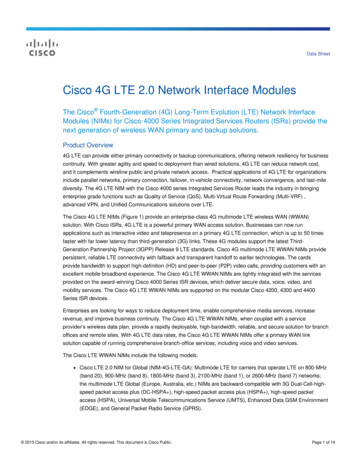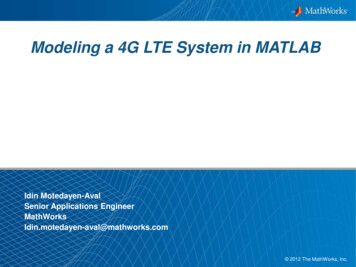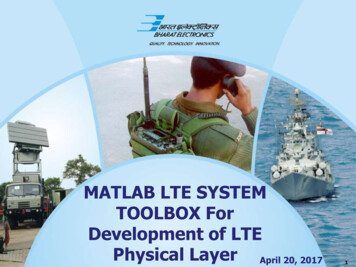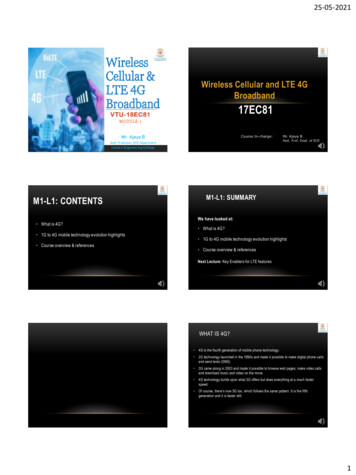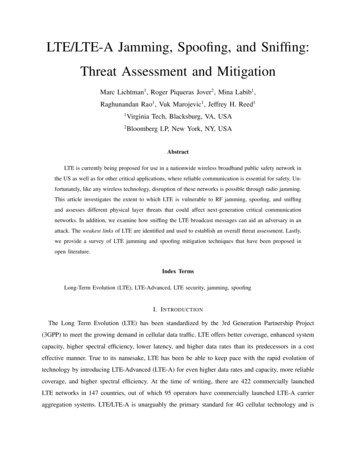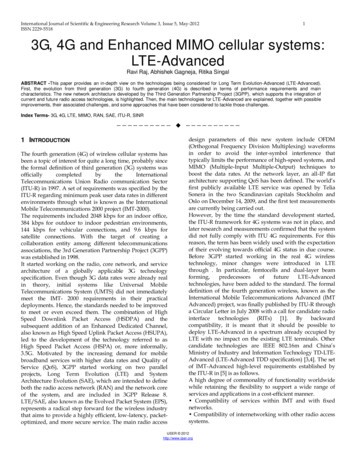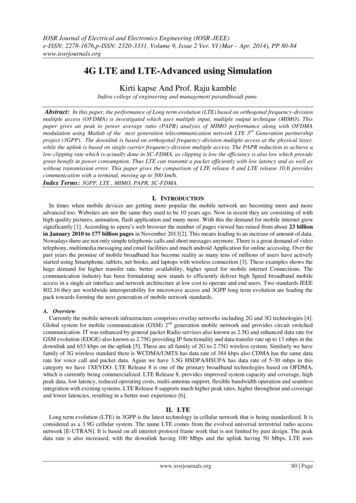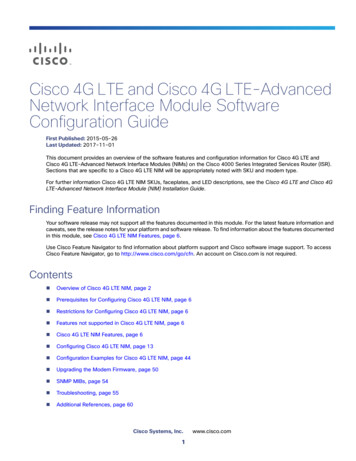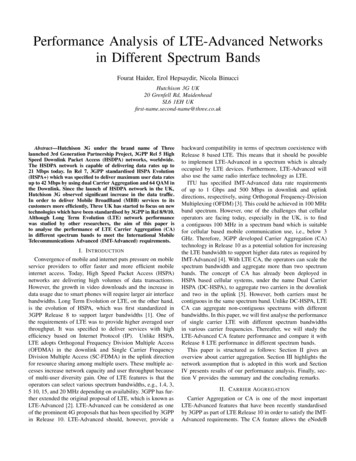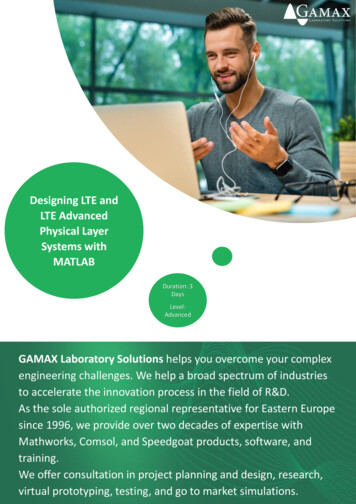
Transcription
Designing LTE andLTE AdvancedPhysical LayerSystems withMATLABDuration: 3DaysLevel:AdvancedGAMAX Laboratory Solutions helps you overcome your complexengineering challenges. We help a broad spectrum of industriesto accelerate the innovation process in the field of R&D.As the sole authorized regional representative for Eastern Europesince 1996, we provide over two decades of expertise withMathworks, Comsol, and Speedgoat products, software, andtraining.We offer consultation in project planning and design, research,virtual prototyping, testing, and go to market simulations.
Designing LTE and LTE Advanced PhysicalLayer Systems with MATLABThis three-day course provides an overview of the LTE and LTEAdvanced physical layer. You will learn how to generatereference LTE waveforms and build and simulate an end-to-endLTE PHY model. This course focuses on OFDMA and SC-FDMAmulti-carrier techniques, MIMO multi-antenna systems, uplinkand downlink LTE physical channels and methods for goldenreference verification with the standard.Prerequisites:MATLAB Fundamentals and knowledge of wireless communicationssystemsTopicsDay 1Day 2 Introduction to 3GPP Long Term Evolution OFDM Theory Review LTE Frames, Slots and Resources Procedures MIMO Background LTE Downlink Physical Layer Modulation MIMO in LTE R8Day 3 LTE Multiplexing and Channel CodingLTE Uplink Physical Layer ModulationLTE Release 9LTE Advanced – Release 10
Training contentDay 1 of 3Introduction to 3GPP Long Term EvolutionObjective: Provide an introduction to the LTE standard and its relationship to other3GPP standards. Understand general requirements and objectives for LTE. Get anoverview of different protocol layers within LTE. 3GPP evolution from R5 to R11RequirementsSpectrum flexibilityGeneral characteristicsMulti-user schedulingResource allocationFrequency reuse planningOFDM Theory ReviewObjective: Understand the basics of OFDM modulation, cyclic prefix insertion, andwindowing. Motivation for multi-carrier vs single-carrierIntroduction to OFDMGeneration of OFDM symbols using the IFFTCyclic prefix (guard interval)Windowing to reduce out of band emissionsAdvantages and disadvantages of OFDMLTE Frames, Slots and ResourcesObjective: Understand the concepts of frames, subframes, slots, and physicalresource grids in LTE downlink and uplink. LTE generic frame structureDownlink and uplink slot formatsResource elements and resource blocksDownlink OFDM symbol constructionUplink SC-FDMA symbol constructionLTE downlink resource capacity
Day 2 of 3ProceduresObjective: Understand different physical layer procedures for both downlink anduplink specified in LTE. Cell searchCell identities in cell searchSymbol synchronizationFrame and cell synchronizationSystem information acquisition: MIBs and SIBsTiming synchronization proceduresUplink power controlMIMO BackgroundObjective: Understand different MIMO techniques namely diversity, beamforming,and spatial multiplexing. Learn about singular value decomposition as the solutionto the generic MIMO problem. Spectral efficiency and capacityTransmit and receive diversityThe Alamouti SchemeDelay Diversity and Cyclic Delay DiversityBeamformingSpatial multiplexingSingular value decompositionEqualizing, predistortion, precoding, and combining
Day 2 of 3LTE Downlink Physical Layer ModulationObjective: Understand processing elements for different downlink physical channelsand downlink physical signals. Learn about resource grid and control channelelement. Downlink physical channel processing chainCodewords and layersScrambling and modulationTransmission schemesDiversity, spatial multiplexing, and beamformingSynchronization signals: PSS and SSSReference signals: cell and UE specific, MBSFNDownlink physical channels: PBCH, PCFICH, PDSCH, and PDCCHControl regionREGs and CCEs, PDCCH search spacesResource grid mappingMIMO in LTE R8Objective: Learn different MIMO techniques specified in the LTE standard. Codewords to layers mappingPrecoding for spatial multiplexingPrecoding for transmit diversityBeamforming in LTECyclic Delay Diversity-based precodingPrecoding codebooks
Day 3 of 3LTE Multiplexing and Channel CodingObjective: Understand the coding, multiplexing, and mapping to physical channelsfor all transport channels in downlink and uplink. Transport channels and control information: DL-SCH, PCH, BCH, DCI, CFI, HI, ULSCH, and UCIMapping of transport channels to physical channelsCRC coding and maskingCode block segmentationConvolutional and turbo codingRate matching, bit selection and pruningTransport channels and control information processing chainsHARQ: incremental redundancy, stop-and-waitLTE Uplink Physical Layer ModulationObjective: Understand processing elements for different uplink physical channelsand uplink physical signals. Uplink physical channel processing chainScrambling and modulationSC-FDMA reviewUplink Reference signals: DRS and SRSUplink physical channels: PUSCH, PUCCH, and PRACHControl information: CQI, RI, PMI, HI, and SRControl signaling on PUSCH and PUCCHPUCCH formatsUplink physical channels and physical signalsLTE Release 9Objective: Learn about new features introduced in LTE Release 9. Release 9 featuresMBMS supportHome eNodeBPositioning supportTransmission schemes
Day 3 of 3LTE Advanced – Release 10Objective: Learn about new features introduced in LTE Release 10. IMT-Advanced TechnologiesCarrier aggregationUplink spatial multiplexingSpatial Orthogonal Resource Transmit DiversityDownlink enhanced MIMOCSI reference signalsShould you have more specific training needs, pleasecontact us about in-person and customized trainingopportunities: training@gamaxlabsol.com
LTE Uplink Physical Layer Modulation LTE Release 9 LTE Advanced -Release 10 Designing LTE and LTE Advanced Physical Layer Systems with MATLAB This three-day course provides an overview of the LTE and LTE-Advanced physical layer. You will learn how to generate reference LTE waveforms and build and simulate an end-to-end LTE PHY model.

